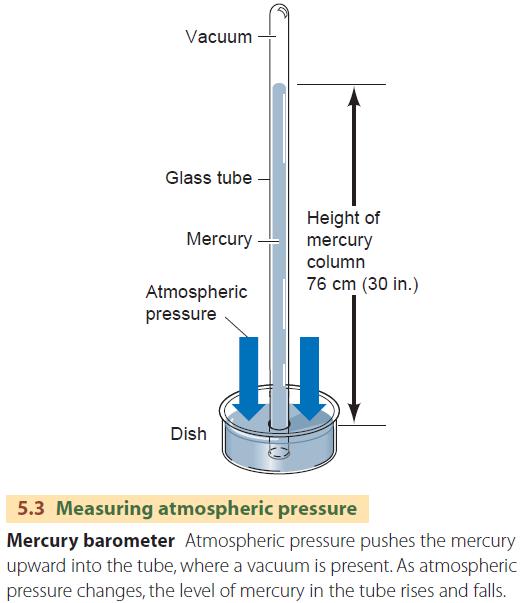Atmospheric Pressure
We live at the bottom of a vast ocean of air—the Earth's atmosphere. Like the water in the ocean, the air in the atmosphere is constantly pressing on the Earth's surface beneath it and on everything that it surrounds. The atmosphere exerts pressure because gravity pulls the gas molecules of the air toward the Earth. Gravity is an attraction among all masses—in this case, between gas molecules and the Earth's vast bulk.
Atmospheric pressure is produced by the weight of a column of air above a unit area of the Earth's surface. At sea level, about 1 kilogram of air presses down on each square centimeter of surface (1 kg/cm2)—about 15 pounds on each square inch of surface (15 lb/in.2). The basic metric unit of pressure is the pascal (Pa). At sea level, the average pressure of air is 101,320 Pa. Many atmospheric pressure measurements are reported in bars and millibars (mb) (1 bar = 1000 mb = 10,000 Pa). In this book we will use the millibar as the metric unit of atmospheric pressure. Standard sea-level atmospheric pressure is 1013.2 mb.
MEASURING AIR PRESSURE
You probably know that a barometer measures atmospheric pressure. But do you know how it works? It's based on the same principle as drinking soda through a straw. When using a straw, you create a partial vacuum in your mouth by lowering your jaw and moving your tongue. The pressure of the atmosphere then forces soda up through the straw. The oldest, simplest, and most accurate instrument for measuring atmospheric pressure, the mercury barometer, works the same way (Figure 5.3).

Because the mercury barometer is so accurate and is used so widely, atmospheric pressure is commonly
expressed using the height of the column in centimeters or inches. The chemical symbol for mercury is Hg, and standard sea-level pressure is expressed as 76 cm Hg (29.92 in. Hg). In this book, we will use in. Hg as the English unit for atmospheric pressure.
Atmospheric pressure at a single location varies only slightly from day to day. On a cold, clear winter day, the sea-level barometric pressure may be as high as 1030 mb (30.4 in. Hg), while in the center of a storm system it may drop by about 5 percent to 980 mb (28.9 in. Hg). Changes in atmospheric pressure are associated with traveling weather systems.
AIR PRESSURE AND ALTITUDE
If you have felt your ears “pop” during an elevator ride in a tall building, or when you're on an airliner that is climbing or descending, you've experienced a change in air pressure related to altitude (Figure 5.4). Changes in pressure at higher elevations can have more serious effects on the human body. In the mountains or at high altitudes, with decreased air pressure, less oxygen moves into lung tissues, producing fatigue and shortness of breath. These symptoms, sometimes accompanied by headache, nosebleed, or nausea, are known as mountain sickness. They are likely to occur at altitudes of 3000 m (about 10,000 ft) or higher.
